Pertussis Toxin
Pertussis toxin (PTX) is produced by Bordetella pertussis, the bacterium responsible for whooping cough. Pertussis toxin is a multi-component protein composed of six non-covalently bound subunits ranging in molecular weight from approximately 9 to 28 kDa. The largest subunit, also called the A protomer, is an enzyme responsible for the ADP-ribosyl transferase activity; the A protomer alone will transfer the ADP ribose from NAD+ to α subunits of G proteins of the class Gαi, Gαo or Gαt. The five-subunit binding complex also known as the B oligomer, allows PTX to enter most cells, attaching to glycan residues present on receptor proteins including TLR4 and glycoprotein Ib. After entering the cell via receptor-mediated endocytosis, PTX is transported retrogradely via the endosomal pathway and Golgi complex to the endoplasmic reticulum. The A subunit is released from the toxin and translocates through the membrane of the endoplasmic reticulum where the toxin inactivates the target membrane-bound G proteins.
Cell biologists use PTX to eliminate G proteins and thereby identify Gi/o protein-dependent pathways. Since toxin receptor is present in several mammalian cell types, pertussis toxin affects most cultured cells. Additionally, pertussis toxin helps to create animal models of autoimmune disease. For example, pertussis toxin is administered to mice along with myelin antigen to create a mouse model of multiple sclerosis, experimental autoimmune encephalomyelitis (EAE).
List labs offers native pertussis toxin, isolated from Bordetella pertussis strain 165. In addition, List Labs also produces a genetically inactive form of pertussis toxin as well as several of the virulence factors associated with Bordetella pertussis infections.
Pertussis Toxin preparations are highly purified, containing all five subunits. Preparations are tested to assure minimal contamination with endotoxin, adenylate cyclase and other virulence factors. Each lot is tested for activity in CHO cells. Native pertussis toxin is supplied in three formulations described below:
- Product #179 Pertussis toxin from B. pertussis strain 165 in glycerol is provided frozen in a glycerol-containing Tris buffer. It will be shipped on ice.
- Product #180 Pertussis toxin from B. pertussis strain 165, lyophilized in buffer is offered freeze-dried in phosphate buffer.
- Product #181 Pertussis toxin from B. pertussis strain 165, lyophilized salt-free is freeze-dried in water and may be reconstituted with water or the buffer of choice.
Pertussis Toxin Mutant
List Labs sells a genetically inactivated form of pertussis toxin, Pertussis Toxin Mutant (PTMUT). This protein may be used as an antigen and as a carrier protein for other antigens.
Pertussis mutant protein is isolated from the TY-178 strain of Bordetella bronchiseptica. Site-directed mutagenesis was used to replace amino acid residues in the enzyme active site. Although diminished, this mutant retains some of the activity of the native toxin.
- Product #184 Pertussis toxin mutant (R9K, E129A) is provided lyophilized in phosphate buffer and an accompanying C of A describes the CHO cell toxicity.
Adenylate cyclase toxin
Adenylate cyclase toxin (ACT) is an important virulence factor secreted by Bordetella pertussis. Encoded by the Bordetella pertussis cyaA gene, adenylate cyclase toxin is a single polypeptide, with an apparent molecular weight of 220 kDa. The N-terminal of this protein contains an adenylate cyclase domain which binds to host cell calmodulin and catalyzes unregulated conversion of cellular ATP to cAMP. The C-terminal, receptor binding domain, contains numerous repeat in toxin (RTX) motifs and is responsible for binding to the cellular receptor on the surface of immune cells, translocation to the cell cytosol and creating cation-selective pores in the host cell membrane.
Adenylate cyclase toxin both suppresses and modulates the host immune system contributing to pathogenesis of B. pertussis. This toxin is unusual in its ability to cross mammalian cell membranes and locate within the cytosol. As a cell biology tool, adenylate cyclase has been used to deliver immunogenic epitopes, targeting antigen presenting cells.
- Product #188L Adenylate cyclase toxin is an active enzyme, produced as a recombinant protein in E. coli. This product is liquid in urea buffer and specific thawing and dilution instructions are provided in an accompanying C of A.
Filamentous hemagglutinin (FHA) Fimbriae 2/3 (Fim)
The initial step in establishing a Bordetella pertussis infection is the attachment of the bacteria to the epithelial lining of the host respiratory tract. Two B. pertussis virulence factors are key in this process, filamentous hemagglutinin (FHA) and fimbriae (Fim). FHA, which is both surface-associated and secreted by B. pertussis, is a multifunctional protein that promotes the attachment of the bacteria through several binding domains. Because FHA is highly immunogenic, it is included in many of the acellular vaccines. Additionally, FHA acts through multiple pathways to modulate the host immune response; an example of this type of activity is induction in macrophages of the secretion of both pro-inflammatory and anti-inflammatory cytokines.
FHA, a large, 220 kDa helical protein is produced by List Labs from the native Bordetella pertussis strain 165. FHA is isolated, provided lyophilized in Tris buffer and is tested for purity and hemagglutination activity.
- Product #170 Filamentous hemagglutinin (FHA)
Fimbriae are extracellular proteins which, like FHA, participate in the attachment of bacteria to substrates. They are long structures which serve to tether the bacteria to surfaces. Based on their recognition by specific antisera, there are two fimbriae serotypes present in B. pertussis, fimbriae 2 (Fim 2) and fimbriae 3 (Fim 3). Fim 2/3 are composed of subunits which dissociate in SDS, producing components with apparent molecular weights of 22,500 and 22,000 Da for Fim 2 and Fim 3, respectively.
Fim 2/3 is isolated from cultures of a Pertactin negative mutant derived from the Bordetella pertussis Wellcome strain 28 expressing a mixture of fimbriae 2 and fimbriae 3. Fim is provided lyophilized in a Tris buffer and tested for purity, endotoxin and reactivity to antibodies. Results are provided in an accompanying C of A. Refer to the C of A for special instructions regarding product reconstitution.
- Product #186 Fimbriae 2/3
Pertactin (PRN)
Pertactin (PRN) is a 69 kDa surface-located protein produced by Bordetella pertussis. Due to its immunogenic and protective properties, it is included in acellular pertussis vaccines. The contribution of this protein to Bordetella pathogenesis is under investigation; however, it appears to play a role in overcoming neutrophil-mediated clearance of Bordetella during early stages of establishing an infection. Pertactin is one of the most polymorphic B. pertussis proteins, occurring in the population in more than 13 variations. Pertactin offered by List is isolated from native cultures of B. pertussis strain 165 and is provided lyophilized in HEPES buffer. Preparations are checked for purity and reactivity to antibodies.
- Product #187 Pertactin (PRN)
Showing all 6 results
-
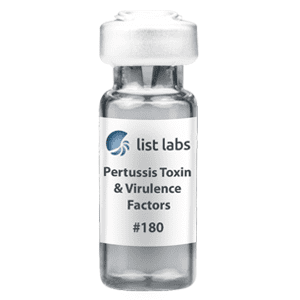
Pertussis Toxin from B. pertussis, Lyophilized in Buffer
#180 (50 ug)
-
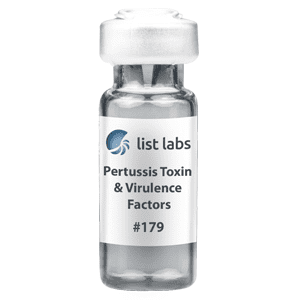
Pertussis Toxin from B. pertussis (in Glycerol)
#179A (50 ug)
-
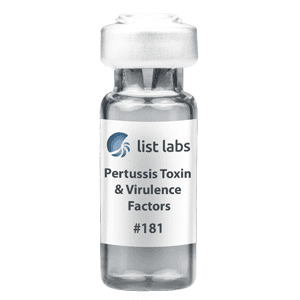
Pertussis Toxin from B. pertussis, Lyophilized (Salt-Free)
#181 (50 ug)
-
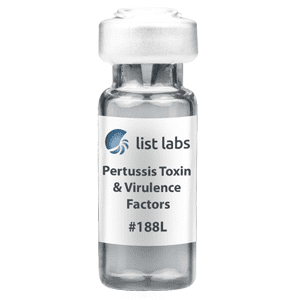
Adenylate Cyclase Toxin, Recombinant from B. pertussis
#188L (Liquid)
-
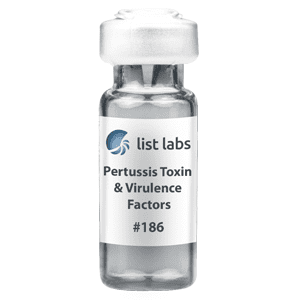
Fimbriae 2/3 from B. pertussis
#186 (50 ug)
-
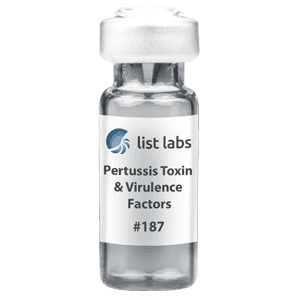
Pertactin from B. pertussis (69 kDa Protein)
#187 (50 ug)


